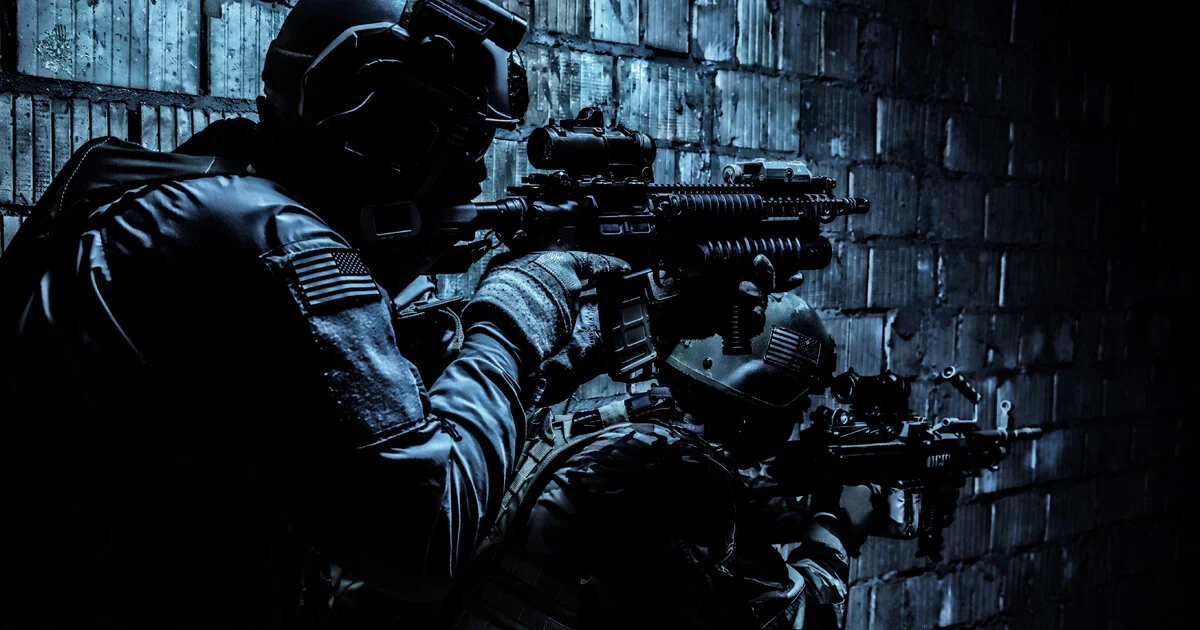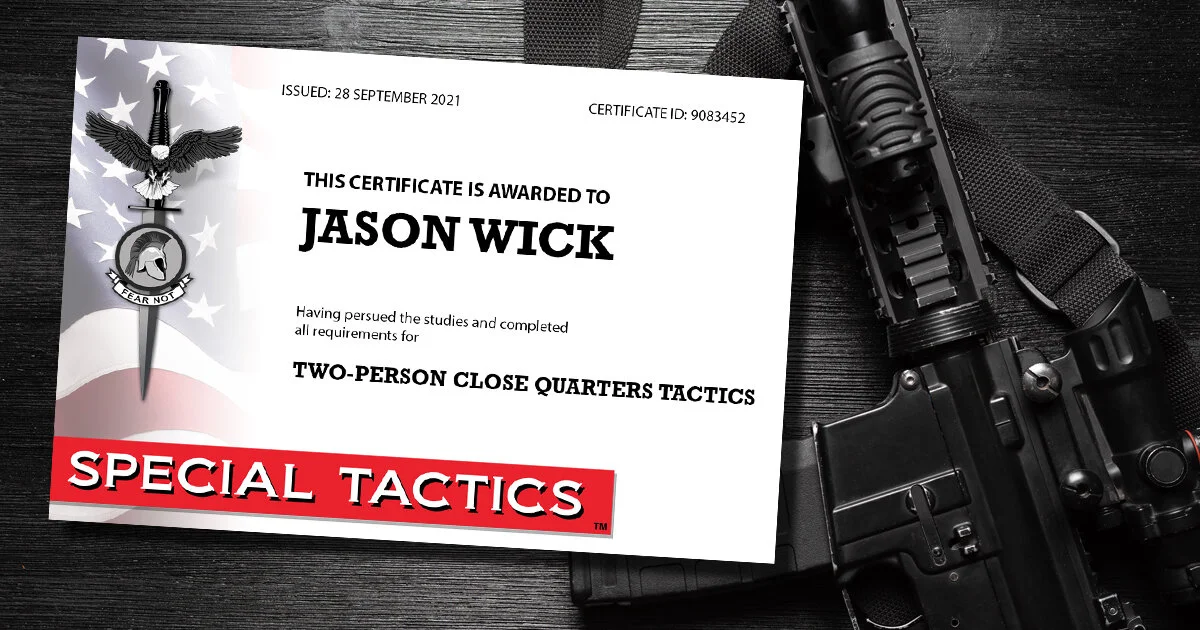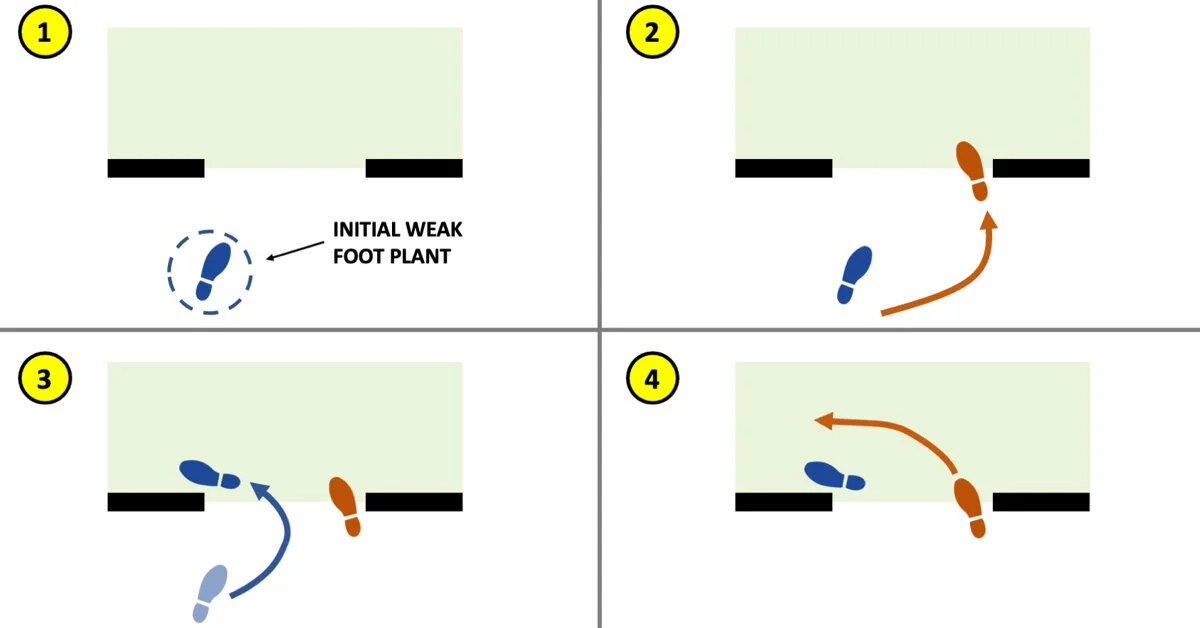If you have to move through an urban environment where threats could emerge from any building or direction, you must be prepared to move tactically in the safest way possible. Urban movement tactics are particularly useful for dealing with terrorist attacks or active shooter (deadly attacker) scenarios. This short article is taken from our Two-Person CQB Online Course and companion book. It provides a brief discussion of how to move and fight in the street or in-between buildings in an urban environment.
Two-Person CQB: Training for the Fight
Training is particularly important for two-person operations. Not only do you need to know how to perform various techniques yourself, but you and your partner need to know how to work as a team and coordinate your actions in a safe manner. Whenever you are operating as a team with more than one person, there is a significant risk of friendly fire. Effective training, practice and rehearsals offer the best way to avoid friendly fire accidents.
Singleton CQB: Shallow Entry Technique (Part 2 of 2)
The shallow entry techniques (sometimes called “limited penetration” techniques) are designed to prevent you from becoming over-committed or trapped deep in a target room. In single-person operations, it is often better to stay closer to a door so you can quickly move through it to avoid threats coming from either direction. This short article is taken from our Single-Person CQB Online Course and companion book. It provides step-by-step instructions for conducting the shallow entry technique. We will explain this technique in two articles. This article explains the second half of the technique.
Singleton CQB: Shallow Entry Technique (Part 1 of 2)
The shallow entry techniques (sometimes called “limited penetration” techniques) are designed to prevent you from becoming over-committed or trapped deep in a target room. In single-person operations, it is often better to stay closer to a door so you can quickly move through it to avoid threats coming from either direction. This short article is taken from our Single-Person CQB Online Course and companion book. It provides step-by-step instructions for conducting the shallow entry technique. We will explain this technique in two articles. This article explains the first half of the technique.
Singleton CQB: Active Shooter and Sniper Response
Unfortunately, deadly attacker (active shooter) situations are becoming more and more common. Most deadly attackers are perpetrating acts of terrorism, are very committed, ready to die and seek to cause maximum death and destruction. This short article is taken from our Single-Person CQB Online Course and companion book. It provides a brief discussion of how to employ the principles of Single-Person CQB tactics when faced with an active shooter (deadly attacker) or sniper attack.
How is Singleton CQB Different from Team Operations?
Single-person (Singleton) CQB tactics are different from tactics developed for teams and multiple teams. The reason for this is the increased risk associated with operating alone. Even if you are very experienced in team-level operations, it may still take time for you to master the specific skills and movements needed for single-person operations. This short article is taken from the introduction to our Single-Person CQB Online Course and companion book. It provides a brief discussion of how CQB tactics change when you are operating alone.
Singleton CQB to Counter a Home Invasion
Since launching our new in-person training initiative we have received some requests to cover single-person (singleton) and two-person close quarters battle (CQB) techniques in a home invasion scenario. The article below is a partial extract from our Single-Person CQB course which is now live on the Tactics Society online academy. We recommend our single-person and two-person CQB courses for any gun owners who want to better protect their homes.
DISCUSSION: A Better Way to Train - Part 1
Many of the world’s premier training and education institutions, including prestigious universities like Harvard and Yale are predominantly still operating the same way they were one-hundred years ago. Are there new, better ways to train that people are ignoring? We want to start by opening up the discussion to our readers. Visit our Facebook page and post your comments under this article.
Join Us for Live, In-Person Training
For the first time, Special Tactics is honored to offer live, in-person training courses for civilians, law-enforcement officers and military personnel provided by senior special operations veterans from Tier-1 Special Missions Units. We will be publishing more articles on our training philosophy and innovative training methods in the days and weeks to come.
Get Certified at our New Online Academy
After many months of work and transition our new online academy is now live through our partnered organization, The Tactics Society. The new online academy is easier to use, more streamlined and offers serial-numbered, printable PDF certificates for the completion of each course.
Small War Tactics: Lines of Operations
Our new book, the Small War Tactics: Professional Handbook is now out on Amazon Kindle. We hope it becomes a valuable addition to your tactical library. The following article is drawn from the book’s introduction, summarizing the various “lines of operation” covered in the book and discussing how to integrate those efforts towards a strategic endstate. There is no fixed way to structure efforts and operations so they integrate together effectively. The key is for leaders to think creatively and collaboratively about the specific problem and the resources/capabilities available to come up with a unique and effective solution.
Small War Tactics: Traffic Control Points (TCP)
The Small War Tactics: Professional Handbook is coming out soon on Amazon Kindle. Here is another short article from the book, this one focusing on how to set up Traffic Control Points (TCP) to support counterinsurgency operations. The nature of insurgent operations also frequently requires them to move. For example, they might need to smuggle explosives in from another region, build a bomb in one location, stage it in another location and then deploy it at a another location. All of this requires movement. By making it more difficult for insurgents to move about, you increase the level of security in the area. Emplacing TCPs is one way to limit insurgent mobility.
New Release: Small War Tactics Professional Handbook
Special Tactics is excited to announce the upcoming release of our new book Small War Tactics: Professional Handbook. The book covers lessons learned from the past 20 years of fighting counterinsurgency battles and low-intensity conflicts around the world. Some specific topics include direct action targeting (F3EAD - unclassified), counter-IED operations, psychological operations, force protection and base defense operations, traffic control point setup and employment, tactical questioning and sensitive site exploitation (SSE). The book will be available on Amazon Kindle in the coming weeks.
Advanced CQB Equipment 1: Assault Kit Introduction
There are no “right answers” when it comes to equipment setup. The most important thing is finding a setup that is effective for you and what works for one person might not work for another. However, it can be helpful to share general ideas and principles or specific tips/techniques when it comes to equipment setup since equipment configuration is a never-ending process and there is always a way to make your kit layout function a bit better. This first article in the Advanced CQB Equipment series covers some of the most basic concepts and ideas relating to kit layout.
Enhance Your Combat Performance: Mastering the Basics
The following article on “Mastering the Basics,” is drawn from the final chapter of Winning the Fight, focused on training and selection. We are happy to announce that “Winning the Fight: A Conceptual Framework for Combat Performance Enhancement” is now available on Amazon Kindle at the link below. Whether you are a law enforcement professional, military service-member, scholar or responsible citizen, Winning the Fight will revolutionize the way you approach your training and help you to greatly improve your combat performance as an individual or as a unit.
Advanced CQB Footwork 3: Limited Penetration Footwork
Limited penetration techniques (or what we refer to as “shallow entry”) have a number of applications. In the most general terms, the purpose of executing a shallow entry as opposed to a deep entry is to minimize your exposure to danger areas deeper in the room and to remain closer to the entry door, making it easier for you to pull back or break contact in an emergency. Shallow entry techniques are more common and widespread than many people realize. For example, when a four-person team executes a traditional “points of domination” room entry technique, the third and fourth person into the room are actually executing a shallow entry (limited penetration) movement to compliment the deep entry executed by the first two assaulters. Therefore, learning the correct footwork for shallow entry can be useful regardless of which CQB system you employ.
Advanced CQB Training 2: "Track" Drills
One very effective drill that can help refine individual CQB performance is the “track drill,” also referred to as “lane training.” The track drill comes from combat-proven special operations training techniques. When conducting CQB training, special operations units will often have several instructors on the catwalk, each instructor responsible for watching and assessing a single student. The track drill modifies this procedure (and in some ways improves upon it) while allowing a single instructor to run training without needing the help of additional instructors.
Advanced CQB Footwork 2: Strong Side Approach
The first article on CQB footwork focused on some basic movement principles for turning right and turning left when coming into a room. However, that article focused primarily on a head-on approach to the door or an angled approach with the “weak side” (non-weapon side) closest to the wall. Generally, approaching the door from the weak side (left side for right-handed shooters) is easier than approaching from the strong side. Therefore, there are some additional footwork techniques and variations that can make a strong-side approach easier and more effective.
Advanced CQB Training 1: How to Train Footwork
It is one thing to learn or understand new footwork techniques. It is another to be able to apply those techniques effectively in a high-stress situation. Mastering footwork requires a great deal of practice and as we mentioned earlier, it is not just about the quantity of practice. The quality of practice is even more important. This article covers some practice/training techniques for refining and optimizing your CQB footwork.
Advanced CQB Footwork 1: Turn Right, Turn Left
One of the most fundamental CQB movements is moving through a doorway and turning to either the right or left to clear the corner. This article does not claim to offer the only way to clear a corner, but rather aims to offer a series of concepts and options to help each individual or team refine their own techniques to a more advanced level.




















